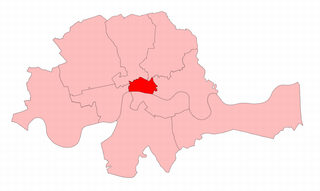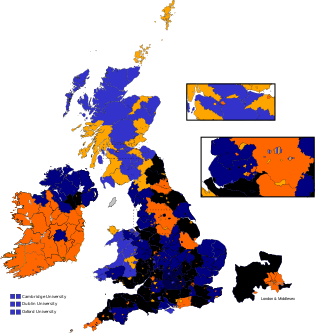
Windsor (/ˈwɪnzə/) is a constituency in Berkshire, currently represented by Jack Rankin of the Conservative Party. It was re-created for the 1997 general election after it was abolished following the 1970 general election and replaced by the Windsor and Maidenhead constituency.
Inverness Burghs was a district of burghs constituency of the House of Commons of the Parliament of Great Britain from 1708 to 1801 and of the Parliament of the United Kingdom from 1801 to 1918. It elected one Member of Parliament (MP).
Inverness-shire was a county constituency of the House of Commons of the Parliament of Great Britain from 1708 to 1801 and of the Parliament of the United Kingdom from 1801 until 1918.
Cambridge University was a university constituency electing two members to the British House of Commons, from 1603 to 1950.
Wigtownshire, was a Scottish constituency of the House of Commons of the Parliament of Great Britain from 1708 to 1801 and of the Parliament of the United Kingdom from 1801 to 1918. It was represented by one Member of Parliament.

The City of London was a United Kingdom parliamentary constituency. It was a constituency of the House of Commons of the Parliament of England then of the Parliament of Great Britain from 1707 to 1800 and of the Parliament of the United Kingdom from 1801 to 1950.

Petersfield was an English Parliamentary constituency centred on the town of Petersfield in Hampshire. It existed for several hundred years until its abolition for the 1983 general election.

West Riding of Yorkshire was a parliamentary constituency in England from 1832 to 1865. It returned two Members of Parliament (MPs) to the House of Commons of the Parliament of the United Kingdom.
Wallingford was a parliamentary constituency in England, represented in the House of Commons of the Parliament of England until 1707, then of the Parliament of Great Britain from 1707 to 1800 and of the Parliament of the United Kingdom from 1801 to 1885.
Egremont was a parliamentary constituency centred on the town of Egremont in Cumberland. It returned one Member of Parliament (MP) to the House of Commons of the Parliament of the United Kingdom, elected by the first past the post system.

East Cornwall was a county constituency in the House of Commons of the Parliament of the United Kingdom. It elected two Members of Parliament (MPs) by the bloc vote system of election.

West Cornwall was a county constituency in the House of Commons of the Parliament of the United Kingdom. It elected two Members of Parliament (MPs) by the bloc vote system of election.

West Cumberland was a county constituency in the House of Commons of the Parliament of the United Kingdom. It elected two Members of Parliament (MPs) by the bloc vote system of election.
Cockermouth was the name of a constituency of the House of Commons of the Parliament of England in 1295, and again from 1641, then of the Parliament of Great Britain from 1707 to 1800 and of the Parliament of the United Kingdom from 1801 to 1918. It was a parliamentary borough represented by two Members of Parliament until 1868, and by one member from 1868 to 1885. The name was then transferred to a county constituency electing one MP from 1885 until 1918.

South Durham, formally the Southern Division of Durham and often referred to as Durham Southern, was a county constituency of the House of Commons of the Parliament of the United Kingdom. It elected two Members of Parliament (MPs) by the bloc vote system of election.
Andover was the name of a constituency of the House of Commons of the Parliament of England from 1295 to 1307, and again from 1586, then of the Parliament of Great Britain from 1707 to 1800 and of the Parliament of the United Kingdom from 1801 to 1918. It was a parliamentary borough in Hampshire, represented by two Members of Parliament until 1868, and by one member from 1868 to 1885. The name was then transferred to a county constituency electing one MP from 1885 until 1918.
Portsmouth was a borough constituency based upon the borough of Portsmouth in Hampshire. It returned two members of parliament (MPs) to the Parliaments of England, Great Britain and from 1801 the House of Commons of the Parliament of the United Kingdom, elected by the bloc vote system.
Liskeard was a parliamentary borough in Cornwall, which elected two Members of Parliament (MPs) to the House of Commons from 1295 until 1832, and then one member from 1832 until 1885. The constituency was abolished by the Redistribution of Seats Act 1885.
Stamford was a constituency in the county of Lincolnshire of the House of Commons for the Parliament of England to 1706 then of the Parliament of Great Britain from 1707 to 1800 and of the Parliament of the United Kingdom from 1801 to 1918. It was represented by two Members of Parliament until 1868 when this was reduced to one.
Flint Boroughs was a parliamentary constituency in north-east Wales which returned one Member of Parliament (MP) to the House of Commons of the Parliament of the United Kingdom and its predecessors, from 1542 until it was abolished for the 1918 general election.





